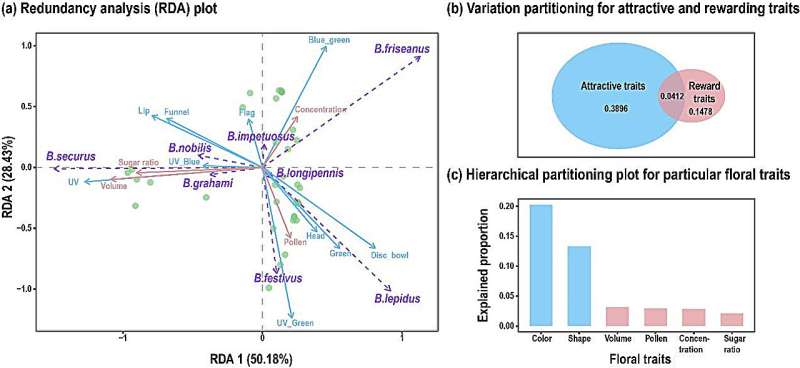This article has been reviewed according to Science X's editorial process and policies. Editors have highlighted the following attributes while ensuring the content's credibility:
fact-checked
peer-reviewed publication
trusted source
proofread
Study reveals floral resource partitioning among coexisting bumblebees at species, colony and individual levels

Understanding how different species manage to coexist in the same community, especially when competing for similar resources, remains a fascinating puzzle in ecology.
Bumblebees, key pollinators in the Northern Hemisphere, depend almost entirely on floral rewards to sustain their life cycles. This dependence underscores not only their ecological importance, but also their vital role in natural and agricultural ecosystems.
In the Hengduan Mountains of the eastern Himalayan in southwest China, it is quite common to observe more than a dozen species of bumblebee coexisting in remarkable abundance within the same community. Elucidating how they overcome the challenge of avoiding excessive competition while using the same floral resources to achieve stable coexistence is an outstanding and unsolved scientific dilemma.
Focusing on the floral resource partitioning among the coexisting bumblebees, researchers from the Wuhan Botanical Garden of the Chinese Academy of Sciences conducted a five-year field experiment in an alpine meadow in the Hengduan Mountains. They documented interactions among 13 bumblebee species and nearly 120 plant species, recording 10,598 connections. At the same time, floral and bumblebee traits were measured.
The study, "Floral resource partitioning of coexisting bumble bees: Distinguishing species-, colony-, and individual-level effects" is published in Ecology.
The researchers provided an in-depth exploration of the principles governing their use of floral resources, analyzed across three distinct levels: species, colony, and individual. They found that the use of floral resources by bumblebees exhibited significant dynamics over the years, but showed clear modularity at both species and colony levels, indicating differentiated strategies for exploiting floral resources.
The primary factors influencing floral resource selection among species were attractive traits such as flower color and shape, with individual-level variability also significantly influencing bumblebee floral resource selection. Although bumblebees displayed apparent strategies to avoid competition in the use of floral resources, the flexibility in their use strategies was remarkably higher than expected.
This study advances scientific understanding of the mechanisms that maintain bumblebee diversity, providing a scientific basis for the conservation of this important strategic resource.
More information: Zhong‐Ming Ye et al, Floral resource partitioning of coexisting bumble bees: Distinguishing species‐, colony‐, and individual‐level effects, Ecology (2024). DOI: 10.1002/ecy.4284
Journal information: Ecology
Provided by Chinese Academy of Sciences



















